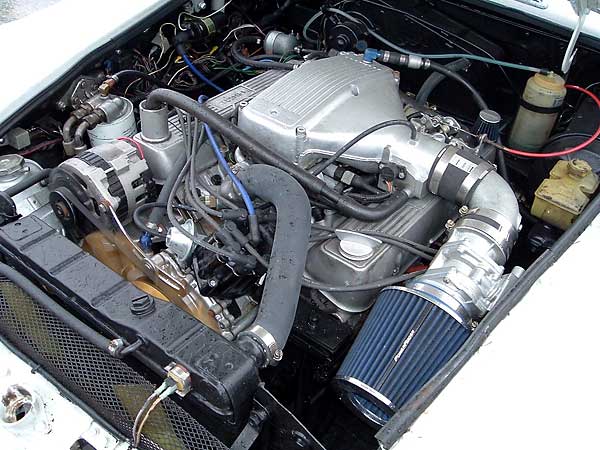
How Glen Towery Installs Rover EFI on MGB V8 Conversions
The British V8 Newsletter, Volume XV Issue 1by: Greg Myer
Glen Towery has been playing around with British cars longer than most of us and has a vast amount of experience with V8 swaps. He's also very willing to share his knowledge, experience and opinions. When I first met him several years ago I acquired a tape he had made about MGB V8 swaps and what was needed to accomplish them. In that tape he highly recommended carburetors and had nothing nice to say about fuel injection. Well, now he's been converted!
It seems he was talked into trying the E.F.I. by a friend and learned a bit about it. Now he swears by it, and not at it. Why? Because of the reliability, power and MPG improvements! The Rover "hot-wire" EFI system can be installed on any Buick or Olds 215, or on Rover 3.5L aluminum V8s. (It was factory installed on the 3.9L and larger versions of this engine.) It works with any compression ratio too. There are a few requirements, as we'll see, but nothing drastic.
Glen uses Rover's "Hot Wire" fuel injection (used from '87 - '95) as opposed
to the 1980 "Federal" fuel injection system that came on the SD1. The Federal
system was thrown into production by Rover to comply with tougher air pollution
emission standards here in the U.S. than they were used to in other world
markets. It was a decent starting point for Rover's fuel injection development
program. The only real problem with it was the only part Lucas supplied: the
ECU. The "Federal" has a totally different intake manifold and plenum from all
the other Rover systems. Rover engineers then produced several generations of
"Flapper-Valve" (Bosch L-Jetronic) based fuel-injection systems, but they
weren't exported to the U.S. market.
Lucas's Hot Wire fuel injection system was state-of-the-art in 1987 when they introduced it at the same time as they finally introduced Range Rover into the U.S. market. Glen says it's a great basis for modern FI for your British V8 project as it's Bullet Proof. In fact, Glen likes it so much he refuses to build motors with carburetors any more.
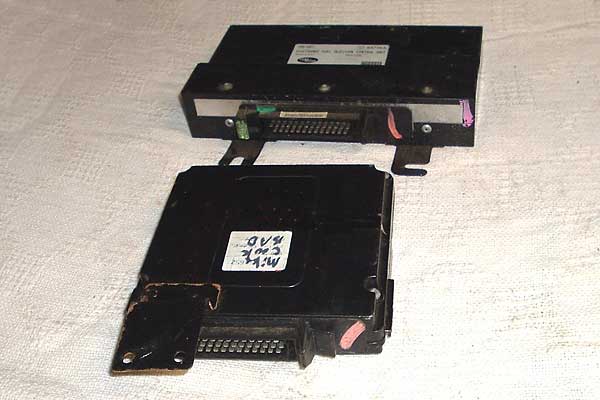
Two generations of Lucas ECU. (Foreground: 14CU or 14CUX. Behind it: 13CU.)
Glen uses a stock computer or Electronic Control Unit (ECU). They change by
motor size so he'll need that info from you if you want one. There were some
changes through the years. The first generation was called "14CU", followed
by the "14CUX" which work for the 3.5 and the 3.9. They can be re-chipped for
a 4.2 if needed. In the 1991 and newer 14CUX units the chip just unplugs
making that modification easy. RPI in Jolly Olde England has them. It's
difficult to tell in the photo, but the plug for the wiring harness is the
same. Glen likes to mount the ECU in the passenger-side footwell where it's
out of the way but easy to access.
The fuel injectors that came on Rover 3.9L, 4.0L, 4.2L and 4.6L engines are all interchangeable. The injector O-rings are GM listed part numbers, making them easy to locate if the need should arise.
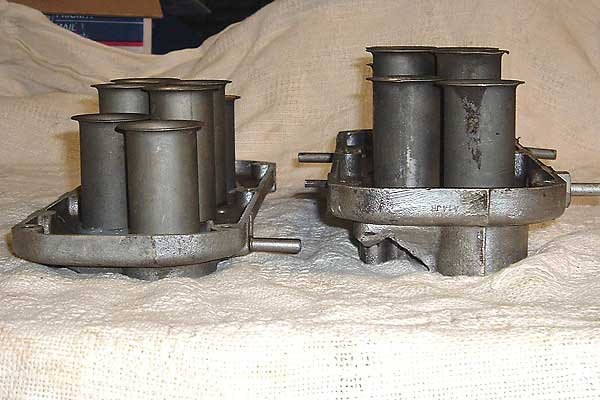
Glen mills 0.800" off the bottom of the Plenum Base to add hood clearance.
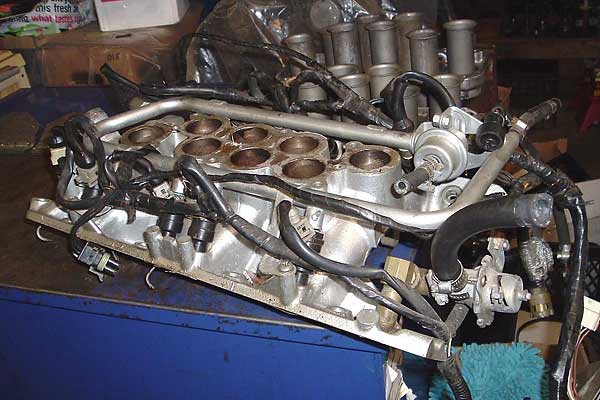
The Rover EFI intake manifold, partially assembled.
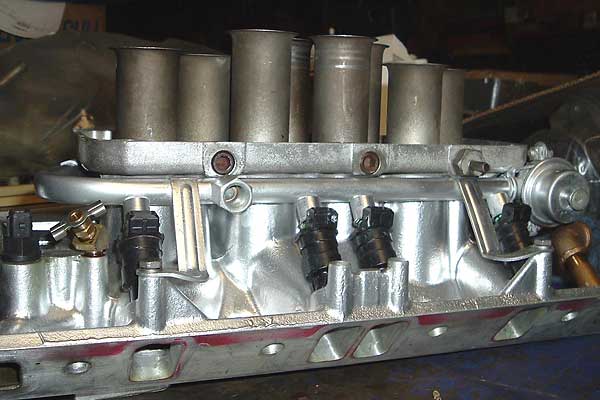
The fuel rail can be lowered slightly by tweaking its mounting feet.
Lucas's Hot Wire fuel injection system was state-of-the-art in 1987 when they introduced it at the same time as they finally introduced Range Rover into the U.S. market. Glen says it's a great basis for modern FI for your British V8 project as it's Bullet Proof. In fact, Glen likes it so much he refuses to build motors with carburetors any more.

Two generations of Lucas ECU. (Foreground: 14CU or 14CUX. Behind it: 13CU.)
The fuel injectors that came on Rover 3.9L, 4.0L, 4.2L and 4.6L engines are all interchangeable. The injector O-rings are GM listed part numbers, making them easy to locate if the need should arise.

Glen mills 0.800" off the bottom of the Plenum Base to add hood clearance.

The Rover EFI intake manifold, partially assembled.

The fuel rail can be lowered slightly by tweaking its mounting feet.
The manifolds changed very little over the years. Some bosses were tapped for
sensors, but not always, so they may appear different but still be the same.
To make the plenum fit under an MGB hood Glen has a couple tricks up his sleeve.
He has 0.800" of aluminum milled off the lower-half of the "plenum" (as shown)
where it mates to the actual manifold. On some tight-fit situations the upper
portion may also be machined. You can see in the photo of the two manifolds
side by side the difference between the stock and modified units.
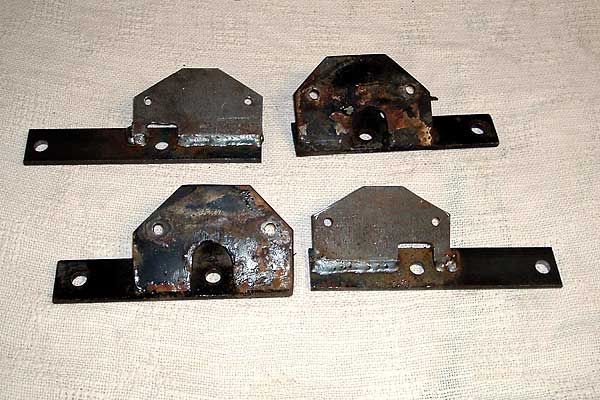
Modified motor mounts (shown upper-left and lower-right) put the engine about a half inch lower than "normal".
This gets close to the clearance needed but Glen also makes lowered motor mounts
too. You can again see the difference in the photo of them side by side. This
will clear most hoods. Speaking of hoods, the steel hood has more clearance in
the plenum area than the aluminum one has.
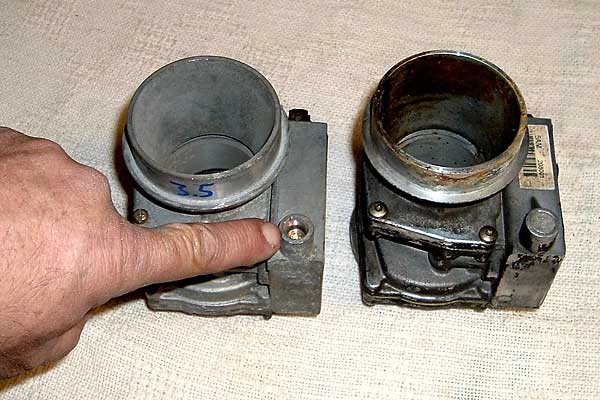
Mass Air Flow (MAF) sensor. (At left, a "tamper proof" plug has been removed to reveal the idle speed adjustment screw.)
The Mass Airflow (MAF) Sensor used by Rover were all the same for these motors.
What Glen is pointing out in the photo is the adjustment for the voltage for
the idle circuit. Speaking of idle quality, computer controlled fuel injection
units need some specifics with regard to cam timing. (The factory cam is fine.)
Glen called up Woody Cooper at The Wedge Shop and put him on the speaker
phone for a quick refresher course. It seems that too much overlap in the
camshaft wreaks havoc with the FI at idle. A cam with 112 degree lobe separation
angle or greater is needed. More lift and duration is no problem however.
Woody can supply a custom grind for your application. Check out The Wedge Shop
for cams, lifters, springs and timing chains. (They've got a beautiful set of
headers for a TR8 too.)
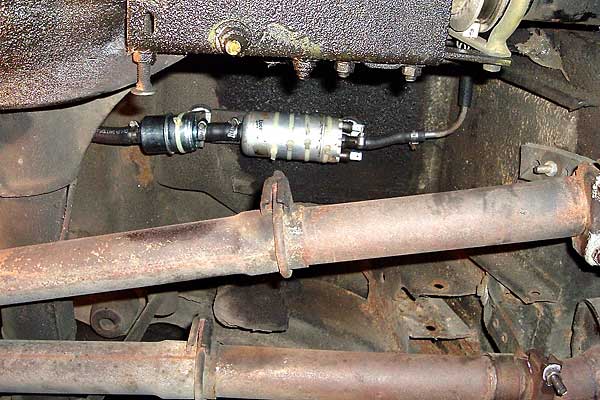
Jaguar inline fuel pump.
Glenn recommends Jaguar XJ6 inline fuel pumps, because they can support the
high pressure and fuel flow needs of the fuel injection system. Some people
have trouble with these Bosch pumps because of where they mount them. Glen
mounts them close to the tank and has no problems with fuel pick up. If you
need a fuel pump, Glen keeps good used ones in stock. The fuel is routed to
the fuel rail, and a bypass allows what isn't used to return to the tank.
Glen's also offers brand new gas tanks with swirl-pots installed. (Editor's note: unlike water, gasoline has very high "vapor pressure" and low "surface tension". This can cause us problems. First of all, compared to other liquids, gasoline doesn't siphon very well to begin with. Secondly, while being pumped and passed through the engine compartment the fuel heats up, and as it heats up it produces vapor bubbles. If these vapor bubbles accumulate in the fuel pump, the pump will "cavitate" and be temporarily unable to supply the engine. The swirl pot helps the bubbles come out of suspension in the liquid fuel.)
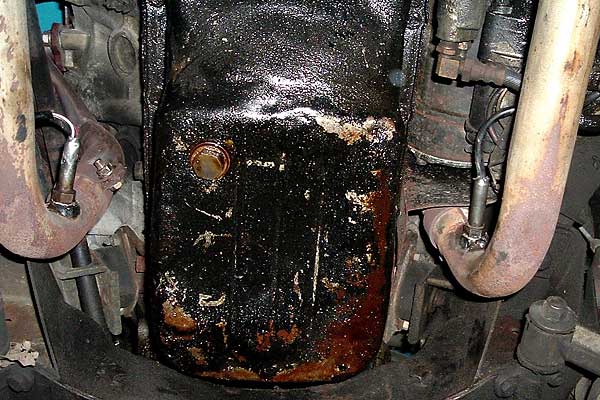
Oxygen sensors should be mounted as far forward in the exhaust flow as feasible.
There are two oxygen sensors too. Because their accuracy improves with heat,
they should be installed as far forward in the exhaust system as feasible.
The wiring harness complements your car's harness, but obviously doesn't replace it. To integrate it into the car, you must hook up four wires. A "hot" lead is easily gotten from the starter. Another lead goes to the coil, plus one to the ignition to sense when it's "ON" and one for the fuel pump inertia switch to cut off power in case of emergency. That switch is also a GM part, available at many local auto parts stores. There are also a couple of grounds to connect. Note: you may need to shorten some grounds. While discussing wiring, Glen recommended soldering new terminals onto the wires. Solder is cheap insurance for hand-crimped terminals. The only problem he ever had was from a crimp-on connector working loose.

Modified motor mounts (shown upper-left and lower-right) put the engine about a half inch lower than "normal".

Mass Air Flow (MAF) sensor. (At left, a "tamper proof" plug has been removed to reveal the idle speed adjustment screw.)

Jaguar inline fuel pump.
|
Enjoying this article? Our magazine is funded through the generous support of readers like you! To contribute to our operating budget, please click here and follow the instructions. (Suggested contribution is twenty bucks per year. Feel free to give more!) |
Glen's also offers brand new gas tanks with swirl-pots installed. (Editor's note: unlike water, gasoline has very high "vapor pressure" and low "surface tension". This can cause us problems. First of all, compared to other liquids, gasoline doesn't siphon very well to begin with. Secondly, while being pumped and passed through the engine compartment the fuel heats up, and as it heats up it produces vapor bubbles. If these vapor bubbles accumulate in the fuel pump, the pump will "cavitate" and be temporarily unable to supply the engine. The swirl pot helps the bubbles come out of suspension in the liquid fuel.)

Oxygen sensors should be mounted as far forward in the exhaust flow as feasible.
The wiring harness complements your car's harness, but obviously doesn't replace it. To integrate it into the car, you must hook up four wires. A "hot" lead is easily gotten from the starter. Another lead goes to the coil, plus one to the ignition to sense when it's "ON" and one for the fuel pump inertia switch to cut off power in case of emergency. That switch is also a GM part, available at many local auto parts stores. There are also a couple of grounds to connect. Note: you may need to shorten some grounds. While discussing wiring, Glen recommended soldering new terminals onto the wires. Solder is cheap insurance for hand-crimped terminals. The only problem he ever had was from a crimp-on connector working loose.
Glen doesn't use the Rover vehicle speed sensor, keeping things simple. He gets
good mileage and emissions without it.
All of this sounds very good. Are there any drawbacks? Well, depends what you want to do. The stock E.C.U. has a rev limiter of 5200 RPM. If you have a lot of 'gear' in the rear, and/or a race cam, you may need to re-chip. Glen likes "torque motors" and they give great gas mileage too. His MGBGT with a 3.5 gets 30 MPG and the one with a 4.2 has gotten 25 MPG in Wisconsin while cruising at between 65 and 85 MPH on 87 octane. Now that was a purpose built motor with 6 inch long P76 connecting rods and Isuzu pistons, but that's another story. This does demonstrate the possibilities, however.
Fuel Injection is fun to drive! There's no lag time or hesitation. There's never any fuel starvation in the corners, making it ideal for autocross or road racing.
The proof is in the pudding as they say. Glen took me for a ride in converted car in the rain. It had been a 3.5L with carburetor and now is a 4.2L with FI. More power and better gas mileage, period! On this car, Glen reports that he's getting fully five (5) miles-per-gallon better fuel economy with the more modern induction system. Compression, cam timing, and other factors affect the outcome, but this swap was of similar types of streetable motors. The increased efficiency of the F.I. was the main reason for the MPG gain.
We went out and Glen started the cold car. It was in the 30's and raining, and some snow and sleet were mixed in. Not a good day for displaying horsepower and cornering ability! I knew this when I left home and didn't bring along my G Tech Pro for data acquisition. What the day did do was provide an environment that would challenge many engines to start and idle and drive smoothly. This car didn't sputter once. No bogs or hesitation. Not a moment's fuss. In fact as we headed out and the car was still cold (the windshield hadn't defrosted yet) Glen was cruising along in 4th gear at 1500 RPM and got into the throttle. The engine pulled well even with the 2.79 gearing out back. I've got to get back there when the weather breaks!
If this sounds good to you and you'd like more information; call Glen. You can also e mail him, but he's a little slower at responding to that as he usually has a wrench in his hand and that can be hard on the keyboard. He'll discuss your needs and make recommendations.
Glen's offers a complete Rover hot-wire electronic fuel injection system, complete and ready to install for less than a thousand dollars. That's certainly something to keep in mind as you plan your next build.
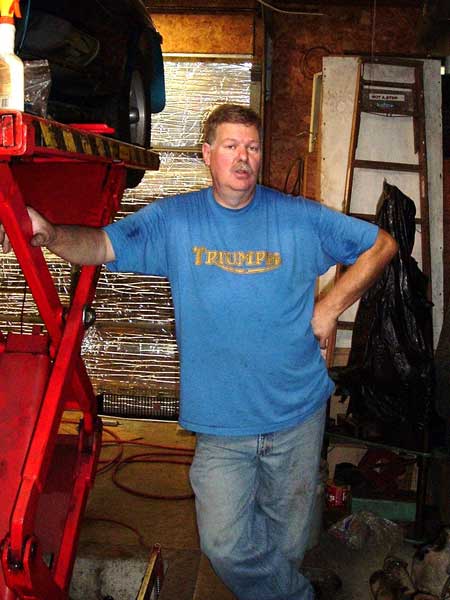
Glen Towery
Disclaimer: This page was researched and written by Greg Myer. Views expressed are those of the author, and are provided without warrantee or guarantee. Apply at your own risk.
Photos by Greg Myer. All rights reserved.
All of this sounds very good. Are there any drawbacks? Well, depends what you want to do. The stock E.C.U. has a rev limiter of 5200 RPM. If you have a lot of 'gear' in the rear, and/or a race cam, you may need to re-chip. Glen likes "torque motors" and they give great gas mileage too. His MGBGT with a 3.5 gets 30 MPG and the one with a 4.2 has gotten 25 MPG in Wisconsin while cruising at between 65 and 85 MPH on 87 octane. Now that was a purpose built motor with 6 inch long P76 connecting rods and Isuzu pistons, but that's another story. This does demonstrate the possibilities, however.
Fuel Injection is fun to drive! There's no lag time or hesitation. There's never any fuel starvation in the corners, making it ideal for autocross or road racing.
The proof is in the pudding as they say. Glen took me for a ride in converted car in the rain. It had been a 3.5L with carburetor and now is a 4.2L with FI. More power and better gas mileage, period! On this car, Glen reports that he's getting fully five (5) miles-per-gallon better fuel economy with the more modern induction system. Compression, cam timing, and other factors affect the outcome, but this swap was of similar types of streetable motors. The increased efficiency of the F.I. was the main reason for the MPG gain.
We went out and Glen started the cold car. It was in the 30's and raining, and some snow and sleet were mixed in. Not a good day for displaying horsepower and cornering ability! I knew this when I left home and didn't bring along my G Tech Pro for data acquisition. What the day did do was provide an environment that would challenge many engines to start and idle and drive smoothly. This car didn't sputter once. No bogs or hesitation. Not a moment's fuss. In fact as we headed out and the car was still cold (the windshield hadn't defrosted yet) Glen was cruising along in 4th gear at 1500 RPM and got into the throttle. The engine pulled well even with the 2.79 gearing out back. I've got to get back there when the weather breaks!
If this sounds good to you and you'd like more information; call Glen. You can also e mail him, but he's a little slower at responding to that as he usually has a wrench in his hand and that can be hard on the keyboard. He'll discuss your needs and make recommendations.
Glen's offers a complete Rover hot-wire electronic fuel injection system, complete and ready to install for less than a thousand dollars. That's certainly something to keep in mind as you plan your next build.

Glen Towery
Disclaimer: This page was researched and written by Greg Myer. Views expressed are those of the author, and are provided without warrantee or guarantee. Apply at your own risk.
Photos by Greg Myer. All rights reserved.
ADDITIONAL INFORMATION
| If you like this article, you'll probably also like: | ||
| 1 | Hot To Service Rover 14CUX Electronic Fuel Injection by Curtis Jacobson, | |
| 2 | British V8 2007 Tech Session: How To Install Rover EFI presented by Jim Stuart, and | |
| 3 | Fuel Injection: Not Such a Black Art by Roger Parker. | |
| You may also like to review how Rover EFI systems have been installed on these sports cars: | ||
| 1 | Evan Amaya's Rover powered 1964 MGB | |
| 2 | Neil Brown's Triumph powered 1968 Triumph TR-250 | |
| 3 | Bob Edgeworth's Rover powered 1972 MGB | |
| 4 | Mark Mallaby's Rover powered MG RV8 | |
| 5 | Scott Miller's Rover powered MG RV8 | |
| 6 | Nick Nicholas's Rover powered MGB | |
| 7 | Jim Stuart's Rover powered 1966 MGB | |
| 8 | Glen Towery's Rover powered 1974 MGB/GT | |
| 9 | Barry Yardley's Rover powered 1977 MGB | |
| 10 | Edd Weninger's Rover powered 1977 MGB | |

